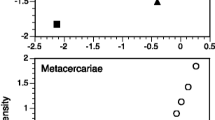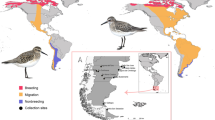Summary
We examine patterns of community richness among intestinal parasitic helminth communities in fishes, herptiles, birds and mammals with respect to the comparative number of component species in a host population. We show that terrestrial hosts have, on average, fewer component species than aquatic hosts. We also show that the mean number of component species in aquatic hosts increases from fishes through herptiles to birds before declining slightly in mammals. For terrestrial hosts, the mean number of component species increases from herptiles, through birds, reaching a maximum in mammals. We conclude that: (i) habitat of the host is more important in determining community richness than is host phylogeny; (ii) the phenomenon of ‘host capture’ may be largely responsible for increased species richness in some host groups; (iii) aquatic birds harbour the richest intestinal helminth communities; and (iv) as we interpret them, our data refute the time hypothesis, which would predict that fishes as the oldest lifestyle should have the richest helminth communities.
Similar content being viewed by others
References
Aho, J. M. (1990) The structure of helminth communities of amphibians and reptiles.Parasite Communities: Patterns and Processes (G. W. Esch, A. O. Bush and J. M. Aho, eds) pp. 157–96. Chapman and Hall, London.
Anderson, R. C. (1984) The origins of zooparasitic nematodes.Canad. J. Zool. 62, 317–28.
Anderson, R. C. (1988) Nematode transmission patterns.J. Parasitol. 74, 30–45.
Baker, M. R. (1984) Nematode parasites in amphibians and reptiles.Canad. J. Zool. 62, 747–57.
Bartlett, C. M. and Greiner, E. C. (1986) A revision ofPelecitus Raillet and Henry, 1910 (Filarioidea, Dirofilariinae) and evidence for the ‘capture’ by mammals of filarioids from birds.Bull. Musee Natle. d'Hist. Natur., Paris 8A, 47–99.
Bartlett, C. M., Bush, A. O. and Anderson, R. C. (1987) Unusual finding of encapsulated nematode larvae (Spiruroidea) inBartramia longicauda andNumenius americanus (Charadriiformes) in western Canada.J. Wildl. Dis. 23, 591–5.
Beckett, J. V. and Gallicchio, V. (1967) A survey of helminths of the muskrat,Ondatra z. zibethica Miller, 1912, in Portage County, Ohio.J. Parasitol. 53, 1169–72.
Birks, H. J. B. (1980) British trees and insects: a test of the time hypothesis over the last 13,000 years.Amer. Natur. 115, 600–5.
Boucot, A. J. (1983) Area-dependent-richness hypothesis and rates of parasite/pest evolution.Amer. Natur. 121, 294–300.
Brooks, D. R. (1979) Testing hypotheses of evolutionary relationships among parasites: the digeneans of crocodilians.Amer. Zool. 19, 1225–38.
Brooks, D. R. (1980a) Allopatric speciation and non-interactive parasite community structure.Syst. Zool. 29, 192–203.
Brooks, D. R. (1980b) Brooks' response to Holmes and Price.Syst. Zool. 29, 214–15.
Bush, A. O. and Holmes, J. C. (1986a) Intestinal helminths of lesser scaup ducks: an interactive community.Canad. J. Zool. 64, 142–52.
Bush, A. O. and Holmes, J. C. (1986b) Intestinal helminths of lesser scaup ducks: patterns of association.Canad. J. Zool. 64, 132–41.
Chabaud, A. G. (1959) Remarques sur l'evolution et la taxonomie chez les nematodes parasites de Vertebres.Proc. Int. Congr. Zool. 15, 679–80.
Chabaud, A. G. (1965) Specificite parasitaire. I. Chez les nematodes parasites de Vertebres. InTraite de Zoologie. Anatomie, Systematique, Biologie. Vol. 4, Part 2. Nemathelminthes (Nematodes) (P. P. Grasse ed.) pp. 548–64. Masson et Cie, Paris.
Dawes, B. (1946)The Trematoda. Cambridge University Press, Cambridge.
Edwards, D. D. and Bush, A. O. (1989) Helminth communities in avocets: Importance of the compound community.J. Parasitol. 75, 225–38.
Glen, D. R. and Brooks, D. R. (1986) Parasitological evidence pertaining to the phylogeny of the hominoid primates.Biol. J. Linn. Soc. 27, 331–54.
Goater, C. P. and Bush, A. O. (1988) Intestinal helminth communities in long-billed curlews: The importance of congeneric host-specialists.Holarctic Ecol. 11, 140–5.
Hoberg, E. P. (1987) Recognition of larvae of the Tetrabothriidae (Eucestoda): Implications for the origin of tapeworms in marine homeotherms.Canad. J. Zool. 65, 997–1000.
Holmes, J. C. and Price, P. W. (1980) Parasite communities: The roles of phylogeny and ecology.Syst. Zool. 29, 203–13.
Holmes, J. C. and Price, P. W. (1986) Communities of parasites. InCommunity Ecology: Pattern and Process (D. J. Anderson and J. Kikkawa eds) pp. 187–213. Blackwell Scientific, Oxford.
Lawton, J. H. and Price, P. W. (1979) Species richness of parasites on hosts: agromyzid flies on the British Umbelliferae.J. Anim. Ecol. 48, 619–37.
Mettrick, D. F. and Podesta, R. B. (1974) Ecological and physiological aspects of helminth-host interactions in the mammalian gastrointestinal canal.Adv. Parasitol. 12, 183–278.
Moravec, F., Prokopic, J. and Shilikas, A. V. (1987) The biology of nematodes of the family Capillariidae (Neveu-Lemaire, 1936).Folia Parasitologia 34, 39–56.
Petrochenko, V. I. (1971a)Acanthocephala of domestic and wild animals. Vol. I. (Translated from Russian, Akademiya Nauk SSSR Vsesoyuznoe Obshchestvo Gel'Mintologov; K. I. Skrjabin ed.). Israel Program for Scientific Translations, Jerusalem.
Petrochenko, V. I. (1971b)Acanthocephala of domestic and wild animals. Vol. II. (Translated from Russian, Akademiya Nauk SSSR Vsesoyuznoe Obshchestvo Gel'Mintologov; K. I. Skrjabin ed.). Isreal Program for Scientific Translations, Jerusalem.
Pojmanska, T. (1982) The co-occurrence of three species ofDiorchis Clerc 1903 (Cestoda: Hymenolepididae) in the European coot,Fulica atra.Parasitology 84, 419–29.
Price, P. W. (1983) Hypotheses on organization and evolution in herbivorous insect communities. InVariable Plants and Herbivores in Natural and Managed Systems (R. F. Denno and M. S. McClure eds) pp. 559–96. Academic Press, New York.
Rey, J. R., McCoy, E. D. and Strong, D. R. (1981) Herbivore pests, habitat islands, and the species-area relation.Amer. Natur. 117, 611–22.
Rigby, M. D. and Threlfall, W. (1981) Helminth parasites of the muskrat (Ondatra zibethicus (L.)) in Newfoundland.Canad. J. Zool. 59, 2172–6.
Riley, J. and Owen, R. W. (1975) Competition between two closely relatedTetrabothrius cestodes of the fulmar (Fulmarus glacialis L.).Z. Parasitenkunde 46, 221–8.
Root, R. B. (1973) Organization of a plant-arthropod association in simple and diverse habitats: the fauna of collards (Brassica oleracea).Ecol. Monogr. 43, 95–124.
Schad, G. A. (1963) Niche diversification in a parasitic species flock.Nature 198, 194–6.
Shoop, W. (1988) Trematode transmission patterns.J. Parasitol. 74, 46–59.
Shults, L. M. (1986) Helminth parasites of the Steller sea lion,Eumetopias jubatus, in Alaska.Proc. Helm. Soc. Wash. 53, 194–7.
Sokal, R. R. and Rohlf, F. J. (1981)Biometry. W. H. Freeman and Company, San Francisco.
Southwood, T. R. E. (1961) The number of species of insect associated with various trees.J. Anim. Ecol. 30, 1–8.
Stock, T. M. and Holmes, J. C. (1987) Host specificity and exchange of intestinal helminths among four species of grebes (Podicipedidae).Canad. J. Zool. 65, 669–76.
Strong, D. R., McCoy, E. D. and Rey, J. R. (1977) Time and the number of herbivore species: The pests of sugarcane.Ecology 58, 167–75.
Stroud, R. K. and Dailey, M. D. (1978) Parasites and associated pathology observed in pinnipeds stranded along the Oregon coast.J. Wildl. Dis. 14, 292–8.
Wardle, R. A. and McLeod, J. A. (1952)The Zoology of Tapeworms. University of Minnesota Press, Minneapolis.
Wazura, K. W., Strong, J. T., Glenn, C. L. and Bush, A. O. (1986) Helminths of the Beluga whale (Delphinapterus leucas) from the Mackenzie River delta, Northwest Territories.J. Wildl. Dis. 22, 440–2.
Wilkinson, L. (1988)SYSTAT: The System for Statistics. Systat, Inc., Evanston, IL.
Wilson, E. O. (1969) The species equilibrium.Brookhaven Symp. Biol. 22, 207–64.
Yamaguti, S. (1959)Systema Helminthum. Vol. II. The cestodes of vertebrates. Interscience Publishers Inc., New York.
Author information
Authors and Affiliations
Additional information
Order of authorship determined by random draw and does not imply seniority.
Rights and permissions
About this article
Cite this article
Bush, A.O., Aho, J.M. & Kennedy, C.R. Ecological versus phylogenetic determinants of helminth parasite community richness. Evol Ecol 4, 1–20 (1990). https://doi.org/10.1007/BF02270711
Issue Date:
DOI: https://doi.org/10.1007/BF02270711




